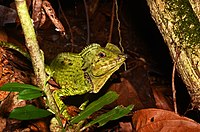Лесные драконы
Материал из Википедии — свободной энциклопедии
| Лесные драконы | ||||||||||||
|---|---|---|---|---|---|---|---|---|---|---|---|---|
 Большой гоноцефал | ||||||||||||
| Научная классификация | ||||||||||||
|
Домен: Царство: Подцарство: Без ранга: Без ранга: Тип: Подтип: Инфратип: Надкласс: Клада: Клада: Класс: Подкласс: Клада: Инфракласс: Надотряд: Отряд: Клада: Подотряд: Клада: Chamaeleontiformes Инфраотряд: Семейство: Подсемейство: Род: Лесные драконы |
||||||||||||
| Международное научное название | ||||||||||||
| Gonocephalus Kaup, 1827 | ||||||||||||
| ||||||||||||
Лесные драконы[1], или гоноцефалы[1] (лат. Gonocephalus) — род ящериц из семейства агамовых, обитающий в Юго-Восточной Азии.
Описание
[править | править код]Общий размер представителей рода колеблется от 30 до 60 см. Характерной особенностью является треугольная форма головы, что отразилось на их названии. Туловище уплощено с боков, конечности относительно тонкие, короткие. Есть гребень из увеличенных чешуй, который тянется вдоль хребта на шее и спине, более развитый у самцов. Имеют горловую сумку, которая растягивается при агрессии. В окраске преобладает сочетание зелёного, жёлтого и коричневого цветов, смешанных в разных пропорциях, на коже хорошо виден узор из пятен неправильной формы. Окраска может меняться в зависимости от состояния животного.
Образ жизни
[править | править код]Обитают в равнинных и горных дождевых тропических лесах. Встречаются на высоте до 1600 м над уровнем моря. Как правило, большую часть времени проводят сидя на вертикальных стволах деревьев, или на концах тонких ветвей. Активны днём. Обычно держатся неподалёку от водоёмов. Питаются членистоногими и мелкими позвоночными.
Размножение
[править | править код]Это яйцекладущие ящерицы.
Распространение
[править | править код]Ареал охватывает Индокитай, Таиланд, Малайзию, Индонезию и Филиппины.
Классификация
[править | править код]На май 2018 года в род включают 16 видов[2][1]:
- Gonocephalus abbotti Cochran, 1922
- Gonocephalus bellii (Duméril & Bibron, 1837)
- Gonocephalus beyschlagi (Boettger, 1892)
- Gonocephalus bornensis (Schlegel, 1848)
- Gonocephalus chamaeleontinus (Laurenti, 1768) — Хамелеоновый гоноцефал
- Gonocephalus doriae (Peters, 1871)
- Gonocephalus grandis (Gray, 1845) — Большой гоноцефал
- Gonocephalus interruptus (Boulenger, 1885)
- Gonocephalus klossi (Boulenger, 1920)
- Gonocephalus kuhlii (Schlegel, 1848)
- Gonocephalus lacunosus Manthey & Denzer, 1991
- Gonocephalus liogaster (Günther, 1872) — Борнеоский гоноцефал
- Gonocephalus megalepis (Bleeker, 1860)
- Gonocephalus mjobergi Smith, 1925
- Gonocephalus semperi (Peters, 1867)
- Gonocephalus sophiae (Gray, 1845)
Галерея
[править | править код]-
Gonocephalus bornensis
-
Gonocephalus doriae
-
Борнеоский гоноцефал
Примечания
[править | править код]- ↑ 1 2 3 Русские названия по источнику: Ананьева Н. Б., Боркин Л. Я., Даревский И. С., Орлов Н. Л. Пятиязычный словарь названий животных. Амфибии и рептилии. Латинский, русский, английский, немецкий, французский. / под общ. ред. акад. В. Е. Соколова. — М.: Рус. яз., 1988. — С. 161. — 10 500 экз. — ISBN 5-200-00232-X.
- ↑ The Reptile Database: Gonocephalus (англ.)
Литература
[править | править код]- Das I (2006). A Photographic Guide to Snakes and other Reptiles of Borneo. Sanibel Island, Florida: Ralph Curtis Books. 144 pp. ISBN 0-88359-061-1. (Gonocephalus species, pp. 81-84).
- Smith MA (1935). The Fauna of British India, Including Ceylon and Burma. Reptilia and Amphibia. Vol. II.—Sauria. London: Secretary of State for India in Council. (Taylor and Francis, printers). xiii + 440 pp. + Plate I + 2 maps. (Genus Goniocephalus [sic], p. 157).
- Honda M., Ota H., Sengoku S., Yong H.S., Hikida T. Molecular Evaluation of Phylogenetic Significances in the Highly Divergent Karyotypes of the Genus Gonocephalus (Reptilia: Agamidae) from Tropical Asia (англ.) // Zoological Science : journal. — 2002. — Vol. 19, no. 1. — P. 129—133. — doi:10.2108/zsj.19.129. — PMID 12025399.
- Pyron R., Burbrink F.T., Wiens J.J. A phylogeny and revised classification of Squamata, including 4161 species of lizards and snakes (англ.) // BioMed Central[англ.] : journal. — 2013. — Vol. 13. — P. 93. — doi:10.1186/1471-2148-13-93. — PMID 23627680. — PMC 3682911.
Ссылки
[править | править код]- Gonocephalus Гоноцефалы, или лесные драконы. Тerraria.ru. (Дата обращения: 13 июня 2018)
Text is available under the CC BY-SA 4.0 license; additional terms may apply.
Images, videos and audio are available under their respective licenses.




